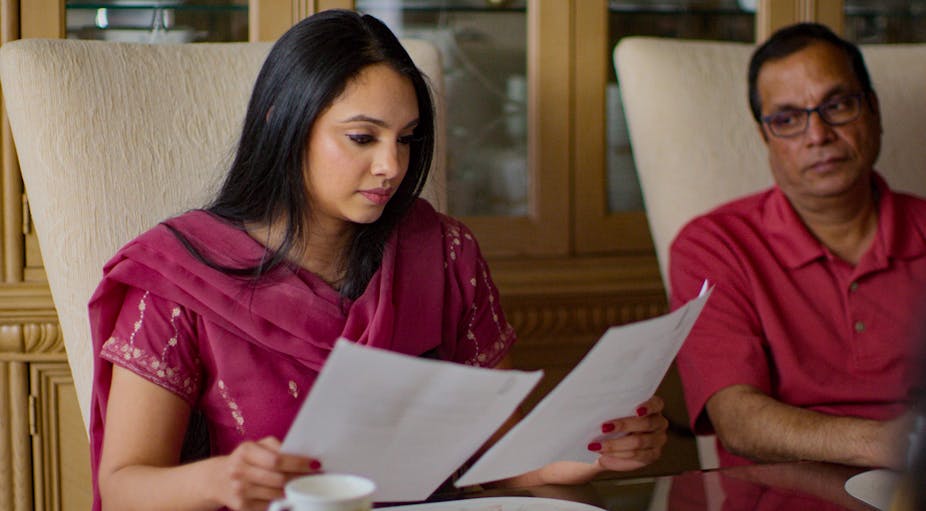After a popular and controversial first season, Netflix’s Indian Matchmaking is back with more Mumbai elites and American Desis (diasporic South Asians) looking for love. The show offers a glimpse into matrimonial negotiations and the arranged marriage process, guided by matchmaker Sima Taparia. Contestants and their families outline their preferences – from values to profession, hobbies to looks – and scrutinise potential partners.
While some criteria are more or less explicit (“must like dogs”), others, such as “good education”, work as implicit references to social class. In India – much like across the globe – good education is synonymous with an English medium education.
This is where English is the language through which all subjects are taught – a model favoured by fee-paying institutions. English speakers are widely assumed to be more educated, more affluent, more modern.
August marked 75 years of Indian independence from British colonial rule. But the English language has continued to play a key role in upholding inequality. For years it remained accessible only to the wealthy.
Over the past two decades, as India’s economic policies shifted, English has become more widely accessible and demand continues to increase. Part of this is due to the longstanding prestige of speaking English, and the narrative that investing in English can bring opportunity and success.
Young Indians are feeling pressure to speak English, both to boost their chances of securing a professional job and to increase the probability of finding a good match for marriage. Unmarried women aspiring to the middle classes are bearing the brunt of the pressure.
In my ethnographic research, I looked at how English gets linked to social mobility in India. I spent several months working alongside young adults at a free English and employability training organisation on the outskirts of South Delhi.
While most of the students enrolled had hopes of becoming socially mobile, many of the young women were also aware that their newly acquired English skills could benefit them in the search for a husband. But, as my interviews with these young women showed, their association with English sometimes ended up backfiring.
In matrimonial negotiations, English is often favoured by both sides, but is increasingly becoming a requirement for women. At times this appears more explicitly transactional. Young English-speaking brides are in high demand for their potential to secure a place at an international higher education institution.
Some have termed this phenomenon “IELTS brides”, indicating young women who have scored highly on the International English Language Testing System. But mostly, the desire for English in a future wife is more about what the language says about her class status and her perceived ability to be a part of modern India.
This was the case for Rupal – one of the teachers from the organisation – who was in the process of meeting potential husbands with her parents when I met her. After attending a school where Hindi was the language of instruction, she joined the organisation as a student to develop her English skills.
She was the first member of her family to speak English, and then trained to become a teacher at the same organisation. Rupal knew that this could be leveraged to find a “better” husband, someone from a more securely middle-class background. Her parents had already rejected a proposal from a young man who had not finished school, arguing that, “My daughter is an English teacher … she is so educated.”
English gave Rupal a form of cultural capital which worked in her favour. This was an advantage that her sister, who had left education early to help financially support the family, was not able to wield.
When English backfires
But, as Rupal told me, “converting” her English capital into marriage appeal was not so straightforward. More than once, Rupal was rejected by the families of potential suitors precisely because she spoke English. Because of the widespread associations between English, modernity and progressiveness, Rupal’s language skills raised suspicions about the type of wife she would be.
Parents of potential matches worried, “She will control my son, she will not allow him to do anything else, she will order [him].” Rather than giving her leverage in marriage negotiations, Rupal’s status as an English speaker was taken by some families as an indication that her behaviour may not conform to what they expected from a woman and a wife.
Pursuing social mobility through the promise of English turned out to be a risky investment. Rupal was forced to carefully balance contradictory demands of “tradition” and “modernity” to show she was capable of being a respectable woman and a good wife. While inability to speak English can disadvantage both men and women, the risks of speaking English are specific to expectations of womanhood.

In its first season, Indian Matchmaking came under fire for its silence on the politics of caste, gender, religion and nationalism. It has been equally quiet on the unspoken dimensions of language on the marriage market, and what speaking certain languages represents socially.
The increasing demand placed on young Indians aspiring to the middle classes to speak English is fuelled by an often unquestioned acceptance of the utility of English across the globe. But what this narrative hides is how English is deeply entrenched in unequal social stratification through class, caste and gender.
Stories like Rupal’s reveal how the lists of criteria for potential matches that Indian Matchmaking puts into the spotlight are less about “personal preferences”, and much more about maintaining social order.

